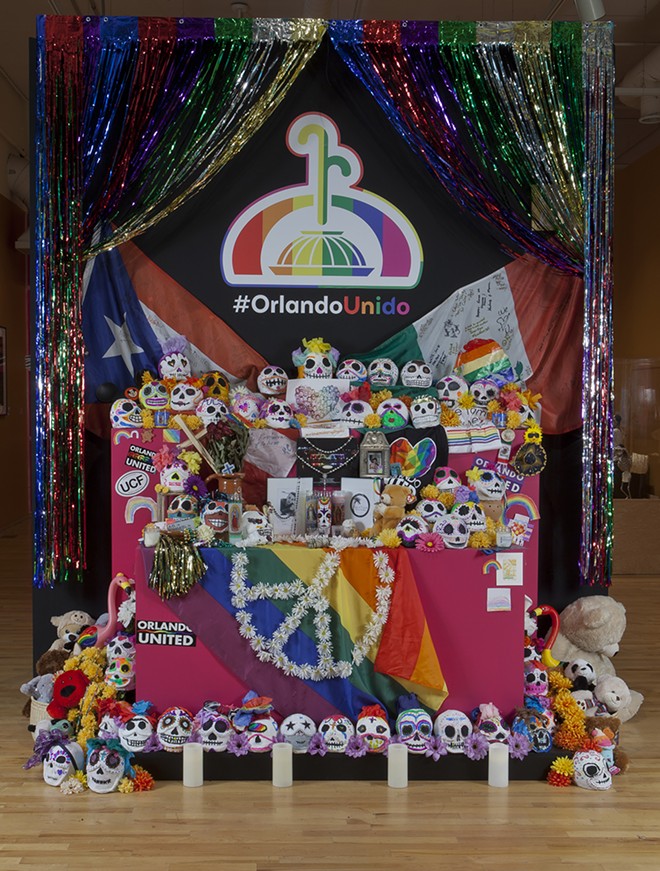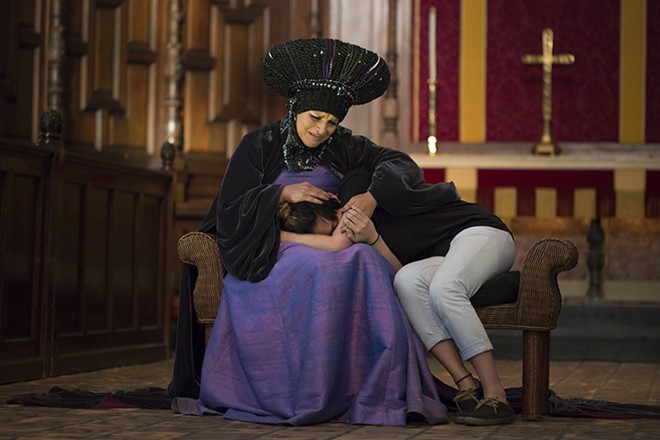On June 12, 2016, a shooter entered Pulse, a gay nightclub on South Orange Avenue, on Latin night, violently and abruptly ending 49 lives in the deadliest mass shooting in United States history. The shockwaves of this tragic event reverberated through Orlando's LGBTQ and Latinx communities, through the nation and the world.
A significant cultural trauma causes changes in the relationships between symbols and meanings, altering the visual culture of a society. The Pulse tragedy has dramatically altered the visual landscapes of Orlando, one of the most obvious and visually striking of these changes being the proliferation of rainbows across the city, in a show of support for the LGBTQ community, and in many ways a recognition and rejection of the culture of intolerance which caused such a tragedy to occur.
Countless local businesses have prominently displayed rainbows in storefronts, small gestures adding up to a very visible show of support for the LGBTQ community. In October of 2016, the Lake Eola bandstand was painted in bright rainbow colors to honor the victims of the shooting. Forty-nine rainbow-hued seats were installed as a memorial at the Orlando City Soccer Club's stadium in January of this year.
Artists have also responded with shows of grief, support and recognition of loss. Many of these responses have been quiet and respectful gestures, community-driven and cathartic, opening spaces for grief and introspection as well as for a strengthening of community bonds.
In Wanda Raimundi-Ortiz's durational performance Pietà, the artist opened her arms to people of color and members of the LGBTQ community in response to the overwhelming deluge of tragedy experienced by these groups – not just the Pulse shootings but other identity-based hate crimes and instances of police brutality. Raimundi-Ortiz also hosted a calavera decorating workshop at the Orlando Museum of Art with organizers of QLatinx, a grass-roots organization dedicated to the advancement and empowerment of Orlando's LGBTQ+ Latinx community. The calaveras created during the workshop became part of a larger installation by Raimundi-Ortiz, a site-specific Dia de los Muertos ofrenda (offering) for Pulse, displayed at Chicago's National Museum of Mexican Art as a part of their yearly Dia De Los Muertos exhibition. Cesáreo Moreno, visual arts director and chief curator of the museum, discussed the social relevance of the Day of the Dead exhibition in a phone interview with Orlando Weekly.
"Every year we, unfortunately, include some sort of ofrenda or site-specific installation that pays homage to recent tragedies that have occurred in the U.S. and the world. In the past we've had ofrendas to events such as the shootings at Sandy Hook Elementary, hurricanes, and deaths of people crossing the border from Mexico into the United States," he says. "Dia De Los Muertos is a beautiful celebration of life. It is a way in which we can, in a healthy way, deal with grief, with tremendous loss, of people in our community and families who we love and want to remember and want to keep their spirit alive."

The 49 Portraits project, on view through June 14 at the Terrace Gallery at City Hall, brings together portraits by different artists of the 49 victims of the shooting, organized by Armstrong State University art professor Mia Merlin. Merlin says, "One thing many artists do is step towards pain, instead of turn away from it. From the artists making these portraits, I heard over and over how very difficult it was to do, and yet they wanted to do it. Their desire to do it came from a wisdom that in the midst of sorrow and loss is where we understand the value of our life, and that our creative response to heartbreak is where we weave straw into gold. They realize that in knowing our pain we know our shared humanity."
In the exhibition What Has Changed? (a partnership between the Orlando Public Library and Sam Flax of Orlando), local artists were asked to create works probing at this far-reaching question. Orlando artist Lesley Silvia, who made work for the exhibition, says, "My contribution borrowed symbolism found in vanitas, playing alongside commonly found animal imagery, to remind Orlando citizens that while the City Beautiful can for the most part be a safe haven for those in the LGBTQ community, Florida itself still has a long way to go as far as legislation is concerned with equal rights." This exhibition opens June 15 at the Orlando Public Library.
A driving force behind each of these contributions to Orlando's visual culture is a desire to build community and acknowledge the specificities of grief borne from the tragedy. The meanings of certain symbols, such as the rainbow, have changed for our city, and a public awareness of the personal tragedies and political struggles within the LGBTQ and Latinx communities has come to define Orlando's culture within the past year.



